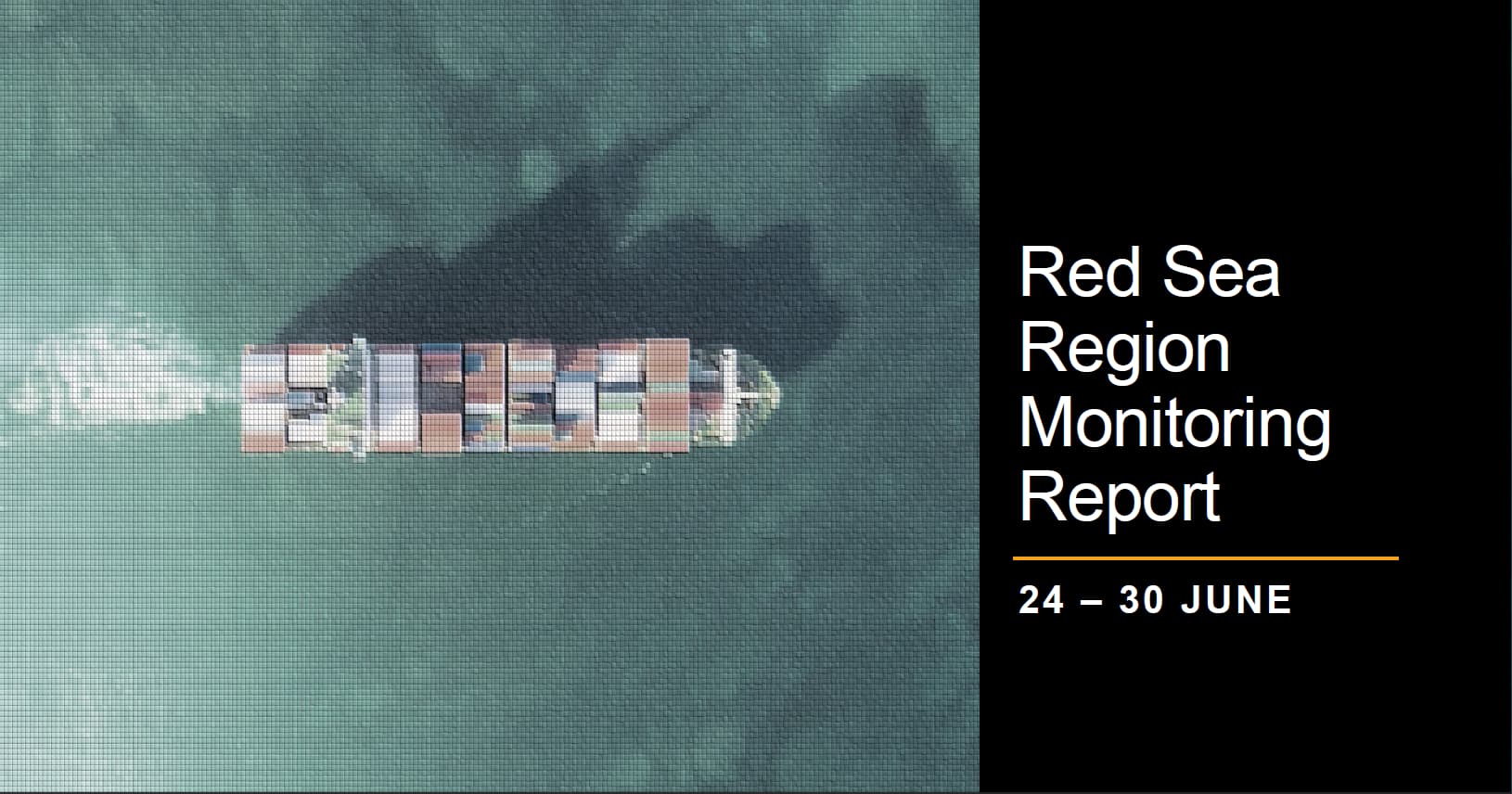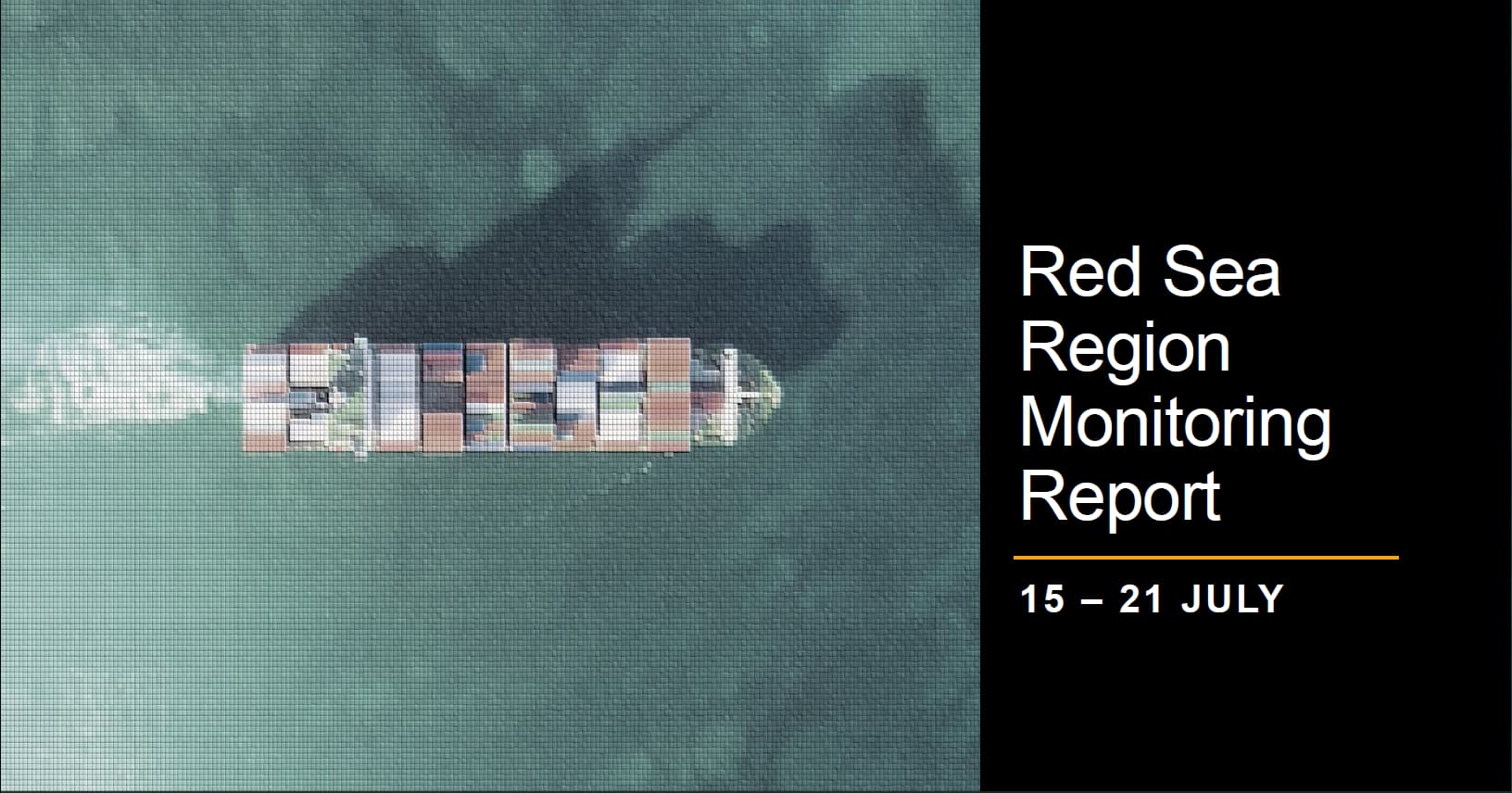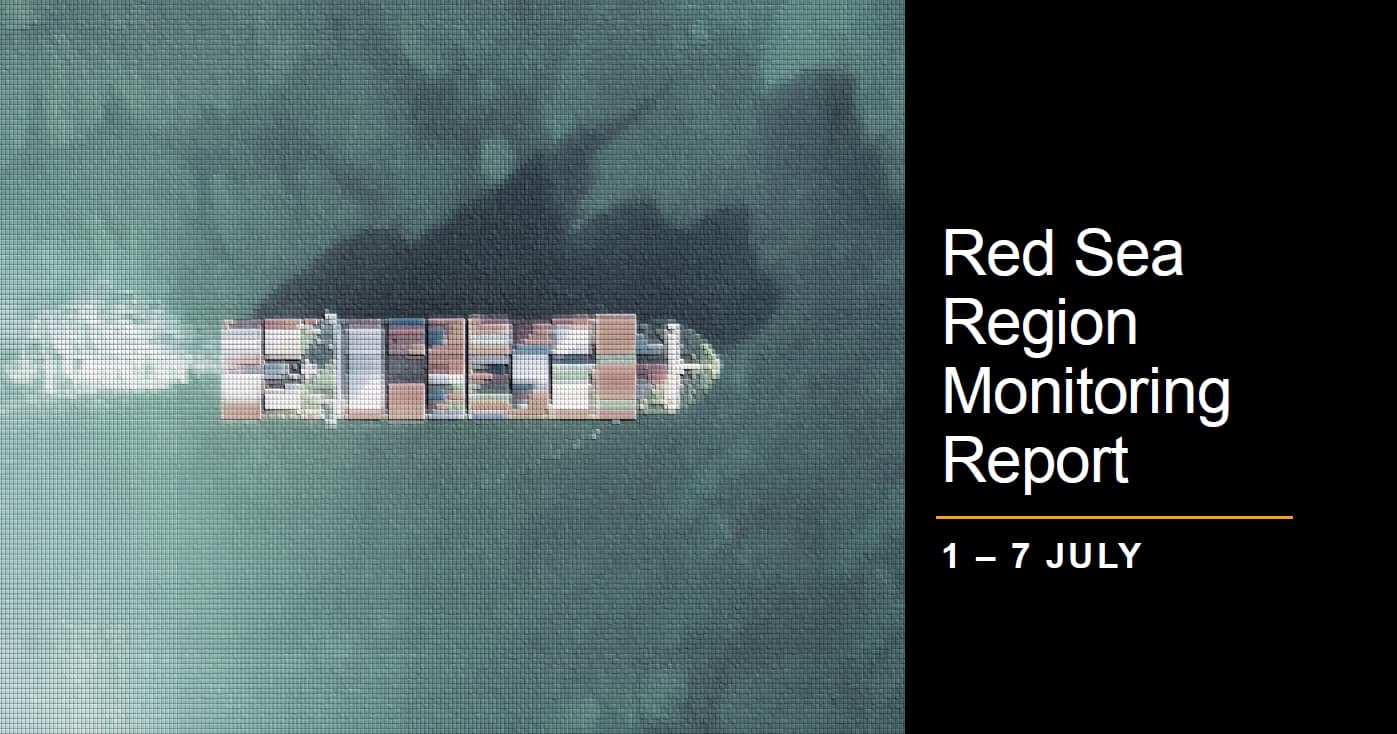KEY DEVELOPMENTS – COMMERCIAL INCIDENTS
During the monitoring period 22-28 April Regal Maritime Solutions (RMS) identified the following incidents in the Red Sea and Gulf of Aden region:
MISSILE STRIKE: On 24 April an explosion was reported in the water in the vicinity of a commercial vessel in the area. The incident occurred around 72NM east south-east off the port of Djibouti. The vessel and crew were reported safe.
MISSILE STRIKE: On 26 April the commercial vessel Andromeda Star reported a missile attack 14NM south-west of Al Mukha, Yemen. The first missile landed in close proximity to the vessel in the water, followed by a second missile which hit resulting in damage to the vessel.
IRANIAN INTELLIGENCE VESSEL: The last reported location of the Iranian intelligence vessel the Behshad was on 18 April in the Persian Gulf in Iranian territorial waters. It was located in the vicinity of coordinates 26° 59′ 26.2″ N, 056° 24′ 35.2″ E located approximately 5NM south of Banda Abbas, Iran and south west of the island of Hormuz.

KEY DEVELOPMENTS – MILITARY ACTIVITY
During the monitoring period 22-28 April RMS identified the following incidents involving US coalition forces in the Red Sea and Gulf of Aden region, obtained from military and open sources:
MISSILE INTERCEPT: On 24 April around 1151 local time, a British naval vessel, HMS Diamond, engaged and destroyed one anti-ship ballistic missile (ASBM) launched from Houthi -controlled areas in Yemen over the Gulf of Aden. The missile was believed to have been targeting the US merchant vessel the MV Yorktown. No injuries or damage were reported by US, coalition, or commercial ships.
UAV INTERCEPT: On 24 April between 1200 and 1330 local time, the US navy engaged and destroyed four airborne unmanned aerial vehicles (UAV) over Houthi-controlled areas of Yemen which was considered as presenting an imminent threat to vessels in the region.
MISSILE INTERCEPT: On 25 April at around 0952 local time one anti-ship ballistic missile (ASBM) was launched from Houthi-controlled areas of Yemen into the Gulf of Aden. No injuries or damage reported any vessels in the region.
USV/UAV INTERCEPT: On 25 April between 1215 and 1630 local time US forces engaged and destroyed one unmanned surface vessel (USV) and one unmanned aerial vehicle (UAV) in Houthi-controlled areas of Yemen after both were considered as presenting an imminent threat to US, coalition and commercial vessels in the region.
HOUTHI UAV INTERCEPT: On 25 April Houthi militants shot down a US MQ-9 Reaper drone with a surface to air missile (SAM). The US military confirmed that a US Air Force MQ-9 drone had crashed in Yemen offering no further details on the circumstances of the incident.
MSSILE ATTACK: On 26 April at approximately 1749 local time Houthi militants launched three anti-ship ballistic missiles (ASBMs) from Houthi-controlled areas of Yemen into the Red Sea in the general direction of the Antiguan/Barbados flagged MV Maisha and UK owned, Panamanian flagged Andromeda Star. The MV Andromeda Star was struck and reported minor damage but was able to continue with its voyage. There were no reported injuries to the crew. The ASBM was reportedly launched from Yemen’s south-western Taiz governate.
UAV INTERCEPT: On 28 April between 0145 and 0230 US forces engaged and destroyed five UAVs over the Red Sea.

KEY DEVELOPMENTS – HOUTHI MISSILE STATISTICS

Figures 1 and 2 identifies the number of missiles, UAV, USVs and UUVs launched, or prepared to be imminently launched, by Houthi militants from Yemen targeting commercial and naval vessels in the Red Sea and Gulf of Aden regions. Figures have incorporated statistics from vessels hit, near misses and pre- emptive strikes on-land in Yemen by US-led Coalition forces but not those resulting from large scale coordinated military action. In some cases the destined target of Houthi weapons including destroyed on-land in Yemen cannot not be verified and has therefore been categorised as ‘Not Known’ (NK). Where no dates are provided there were no reported incidents or data available for that period.
ANALYSIS: Houthi missile launches have recommenced in both the Gulf of Aden and southern Red Sea after a temporary lull following the Iranian and Iranian proxy air attacks on Israel over 13-14 April. The attacks over this reporting period saw launches in both maritime regions with a visible increase in activity in the Red Sea region towards the end of the reporting period as a consequence of roaming UAVs.
KEY DEVELOPMENTS – SECURITY INCIDENT MAPPING


REGIONAL DEVELOPMENTS
During the monitoring period 22-28 April RMS identified the following key regional developments:
Houthi militants in Yemen have renewed their attacks in the region after a temporary lull following their participation in the Iranian missile and UAV strikes on Israel on 13-14 April.
The UK’s Office for National Statistics (ONS) confirmed maritime traffic through the Suez canal in Egypt fell by 66 percent between mid-December 2023 and the beginning of April 2024 after a number of commercial vessels decided to divert due to Houthi attacks on vessels in the region. Container prices have also reportedly increased by 300 percent in 2024 as a consequence. Maritime traffic through the strait of Hormuz, off the coast of Iran also saw a drop between the months of February to April 2024.
On 27 April Iran’s foreign minister said the crew of the seized Portuguese-flagged vessel, the MSC Aries have been granted consular access and are expected to be freed. Iran’s Revolutionary Guards seized the vessel MSC with 25 of its crew in the Strait of Hormuz on 13 April, days after Tehran vowed to retaliate for a suspected Israeli strike on its consulate in Damascus.
On 27 April Israel’s foreign minister Israel Katz indicated his government may suspend its
planned Rafah ground offensive should an agreement be reached with Hamas.
A Hamas delegation is set to visit Cairo, Egypt on 29 April for talks aimed at securing a ceasefire. Mediators have stepped up efforts to achieve a deal between Hamas and Israel ahead of an expected Israeli assault on the southern city of Rafah.
On 28 April Hamas representatives stated that the group had no major issues with
Israel’s latest proposal for a ceasefire and hostage deal, according to AFP.
On 28 April, the French foreign minister Stephane Sejourne met with Lebanese government officials to discuss proposals put forward by the French government to ease tensions between Israel and Hezbollah. Sejourne indicated later in the day that progress had been made.
On 28 April US President Joe Biden spoke with Israeli Prime Minister Benjamin Netanyahu regarding the latest ceasefire talks being discussed and the release of hostages held by Hamas. Duirng the course of their conversation Biden made it clear that the US would not support and Israeli ground operation in Rafah without a clear humanitarian plan.
On 28 April during the World Economic Forum (WEF) hosted in Saudi Arabia, the Kingdom of Saudi Arabia called regional “stability”, warning of the effects of Israel’s ongoing war on Gaza on global economic sentiment.
A number of representatives involved in Gaza mediation efforts including US Secretary of State Antony Blinken, Palestinian leaders and senior officials from other countries were listed as attending the WEF in Riyadh considered as a backdrop to pursue continued diplomatic efforts in ceasefire talks between Israel and Hamas and humanitarian efforts for the Palestinian enclave.
On 28 April the Popular Front for the Liberation of Palestine (PFLP) warned the UK and any other country against deploying troops on the land or on the coast of the Gaza. According to Ma’an News Agency, the PFLP confirmed in a statement that foreign forces will be treated as occupation forces, and will be legitimate targets for the resistance.
ASSESSMENT
- Houthi militants in Yemen have renewed their attacks in the region after a temporary lull following their participation in the Iranian missile and UAV strikes on Israel on 13-14 April.
- Houthi attacks will continue to target commercial and military vessels in the Red Sea and Gulf of Aden in particular any vessels considered linked to Israel, the US and UK.
- Any ceasefire between Israel and Hamas, may see a temporary pause in attacks by the Houthis on commercial shipping.
- Israel will continue to maintain an aggressive posture toward Iran over the coming months and likely to continue to target Iran-associated assets across the region.
- Iran will continue to smuggle weapon components to Houthi militants via shipping vessels and smuggling networks within the territory controlled by Yemen’s internationally recognised government (IRG).
- Houthi use of outdated and inaccurate data pertaining to target identification continues placing maritime vessels previously linked to Israeli, US or the UK at risk of misidentification. The Houthis will likely be taking greater care not to target vessels associated to China and Russia.
- The US and its partners will continue to conduct pre-emptive strikes against Houthi targets on-land in an attempt to degrade Houthi military capability and prevent it to be used to target commercial shipping and from being used as a platform to target Israel.
- The US will continue to intensify efforts to intercept vessels smuggling weapon components from Iran to the Houthis in Yemen and expand intelligence collection methods to enhance maritime interdiction operations, as well as coordinate military strikes against Houthi weapon sites, facilities and capabilities in Yemen.
- The US government will continue to push for a diplomatic solution for the Israel-Hamas conflict with regional partners due to the ongoing humanitarian crisis in Gaza and attempt to dissuade wider conflict from escalating in the region and an Israeli offensive in the Gazan city of Rafah.
- Piracy incidents around the Horn of Africa is expected to continue albeit at less intense rate as previously expected, largely as a consequence of effective maritime interventions by the Indian navy in the Indian Ocean.
- The Indian navy will continue to utilise coercive measures to resolve piracy incidents and to deter PAG activity in the Indian ocean region.
RECOMMENDATIONS
- Avoid being in vicinity of Iranian Behshad vessel. Avoid where possible transiting locations within the UAE and Iranian coastlines due to the risk from Iranian military boarding parties.
- Be aware of US, coalition or Israeli Navy activity nearby in north of Red Sea, Bab-al-Mandab strait and Gulf of Aden, and Iranian activity in the Arabian sea.
- Vessels operating in the Indian Ocean area are urged to heighten their vigilance due to increased likelihood of Pirate Activity Groups (PAGs) operating in the area.
- Report any Suspicious Sightings and be aware of the risk of Unmanned aerial Vehicle (UAV) / drone and Uncrewed Surface Vehicle (USV) attack.
- Consider utilising a digital monitoring system, which incorporates UAV/UUV drone monitoring to warn of potential attack and use of physical barriers, such as nets and underwater barriers, that can be deployed to prevent UUVs from approaching a ship. These barriers can entangle or obstruct the movement of a UUV..
- Ensure crew conduct drills and training exercises to respond to UUV threats so that they are well-prepared to take appropriate action in the event of an incident.
- Follow guidance on loitering munitions as per the OCIMF website: https://www.ocimf.org/publications/information-papers/loitering-munitions-%E2%80%93-the-threat-to-merchant-ships
- Implement and review BMP5 in particular section 2, which describes non-piracy threats and the Global Anti-Piracy Guide.
- Consider mentioning vessel location to Flag Authorities.
- Inform UKMTO/MSCHoA of vessel movements.
- Ensure radar is kept on.
- Communicate with local agents for any local information or intelligence.
- Keep VHF Ch16 on and pay attention to advisories. Ensure strict surveillance of communications and establish communication with all approaching vessels.
- Do not allow small boats to approach or dock. Consider utilizing an armed security team aboard.
- Ensure there is Hard Cover available if on deck and that it is accessible.
- Ensure a Secondary Muster Station is considered and identified to crew and not just the citadel.
- Maintain Bridge Watches. (Please be aware at night, small, slow vessels without a wake are difficult to detect on radar). Keep Traffic on Upper Deck to a minimum
- Ensure all fire-fighting equipment is checked and available for immediate use. Including the emergency fire pump and that relevant maintenance has been conducted.





